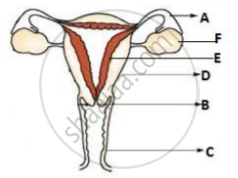Advertisements
Advertisements
प्रश्न
How is juvenile phase different from reproductive phase?
उत्तर
| Juvenile phase | Reproduction phase |
| Juvenile phase is the period of growth between the birth of an organism and before its reproductive maturity. | The reproductive phase is the period of growth after juvenile phase when an individual attain reproductive maturity and reproduces. |
संबंधित प्रश्न
How do organisms, whether reproduced asexually or sexually maintain a constant chromosome number through several generations? Explain with the help of suitable example.
Advantages of sexual reproduction.
Which species is likely to have better chances of survival - the one reproducing asexually or the one reproducing sexually? Justify your answer.
What is the other name of sex cells?
Name the male and female gametes in animals.
Describe the various steps involved in the sexual reproduction in animals. Draw labelled diagrams to show the fertilisation of an ovum (or egg) by a sperm to form a zygote
One of the following process does not lead to the formation of clones. This is :
(a) fission
(b) fertilisation
(c) fragmentation
(d) tissue culture
Put a tick mark (✓) against the correct alternative in the following statement:
Amoeba is most commonly reproduced by:
Multiple choice question. Tick (✓) the correct choice:
Butterfly in its development from larva to an adult shows
- multiplication
- metamorphosis
- fertilisation
- none of the above
Multiple choice question. Tick (✓) the correct choice:
Which of the following glands is responsible for bringing about changes during adolescence in boys and girls?
- pituitary
- adrenal
- thyroid
- testis
Differentiate between the following:
Sperm and Ovum
Mention the common method of reproduction in Hydra.
Mention the functions of Oviduct.
Describe the different methods of asexual reproduction in animals.
Adolesecence is considered a critical stage in the life of boys and girls. Explain this statement.
Meiosis is an essential event in the sexual life cycle of any organism. Give two reasons.
Explain why variations are observed in the offsprings of sexually reproducing organisms?
Answer in one sentence.
Outline the path of sperm upto the urethra.
Answer in one sentence.
Enlist the external genital organs in the female.
Give an account of external genitalia in human females.
Describe the histology of testis with help of labelled diagram.
Identify the labels from the given diagram.

What are the different stages of sexual reproduction?
Give reason for the following:
A male honey bee has 16 chromosomes whereas a female has 32 chromosomes.
Name the phenomenon where the female gamete directly develops into a new organism with an avian example.
In sexual reproduction, offsprings resemble the parents ______.
Which of the following is a primary sex organ in a mammal?
Explain the two types of fertilization.
'Fertilisation is not an obligatory event for fruit production in certains plants'. Explain the statement.
